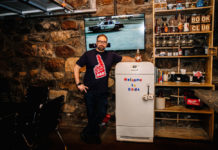Just like many of their customers, the once-humble sports bar/restaurant is poised to graduate into a more complex, mature and global marketplace. Here we have additional coverage from the feature article in our Feb 2015 issue.
By Elyse Glickman
Schultz of Slater’s 50/50 points out that as customers become more sophisticated, they are as invested in supporting other local businesses beyond the sports teams. He observes that as craft beer continues to be the fastest growing segment in their business, they endeavor to have the best local craft beers, which can differ by location.
“We don’t run a corporate-style list,” he explains. “The San Diego’s Slater’s will have a list of San Diego-centric beers, and the Pasadena location will have a lot of L.A.-centric beers.”
Lyons adds that as Richmond, VA has 17 small craft breweries, and Norfolk has three craft breweries, bringing them into the beverage program not only encourages local regulars to support local businesses but also bolsters tourism in the area.
“We have local brewers like Smart Mouth Brewing and Young Veterans Brewing,” he says. “Because the trend is huge we have 24 draft beers, and 12 are small craft beers. People may only confine their order two drinks, but they want a story behind the craft beers they order.”
Carpinella says that Chickie’s and Pete’s actively supports their craft brewers and spirits distilleries in order to, literally, keep the flavor local in a direct and meaningful way. They also create a sense of community for the fans.
“We do seasonal things, such as offering locally-crafted pumpkin beers during the months of October and November, which set us apart from other competitors,” he says. “At one of our biggest locations near the Philadelphia sports complex , and one thing we do is offer a shuttle service from the restaurant to the game, and back to the restaurant. Customers park their car with us rather than deal with the large lot, tailgate with us before the game, and then come back after the game for a bite. This makes for an ultimate game-day experience beyond the old definition of the sports bar.”
In Las Vegas, meanwhile, Mike Nigro, Managing Member/Owner of Distill, says customer loyalty programs play unique roles in a climate where sports bars are also gaming bars. While following current food, beer and cocktail trends is a given, and there are at least 20 televisions at each of the locations, they cannot ignore the fact that the customers will be playing slots and video poker while the games are going.
“We like to create positive energy in our places, and in order for us to do that, we plan events at the venues regularly, whether they are charity events, theme parties like our Hillbilly Ball (which we have once a year at several of the locations),1980s parties and so on,” he details. “Each bar has a budget for a certain amount to spend on events to drive customer traffic. We also spend a lot on looking after individual gamers who are loyal customers. We throw special parties just for them, we take them to concerts and sporting events, and we try to do as many customer appreciation activities as possible. We rotate, doing events open to all customers one month, and the next, doing customer loyalty activities for certain high frequency customers.”
Gearing Up With New Technologies
NoWait’s Panza observes, “Out of necessity, bartenders at sports bars are mixologists-very sophisticated people who know a lot about making great drinks. All of this needs to be considered in terms of owning your market share, and to get that market share. it is not enough to have a guy behind the bar pulling a lever anymore. People want to know about what they are drinking and what’s in the cocktail or food, why should they pick one beer over another and so on.”
In addition to keeping food and beverage options current, sports bar-restaurants face the ongoing issues of game-time crowd control, customer comfort and efficiency of service. Given that an overcrowded space or poorly organized service can result in bottom line loss, emerging crowd management technologies such as the NoWait app, can remedy these issues, according to Panza.
“We looked at things set up for fine dining restaurants where customers could make advanced reservations online,” he explains. “But with casual dining, we would on many occasions and end up standing and waiting for a seat at a bar for over an hour, holding one of those little buzzers. We thought there had to be a better way to accommodate customers with prevalent use of iPhones. NoWait, what resulted, starts with an iPad at the host stand. With this in place, the management can manage customers at the front of the house better, seat them more efficiently and improve the overall quality of the experience.”
Customers can use NoWait to look up their favorite sports bars, find out what the wait time is and put their names on a wait list for a table before they arrive at the restaurant. It’s a non-reservation kind of reservation, cutting down the waiting in line and standing around part of the experience, staring at a wall rather than watching the game or having a relaxed conversation.
“(Owners need to think) beyond the bar area itself,” continues Panza. “While there’s the bar area with bar stools and high top (tables) where people can watch the game and have a quick bite, a dining room needs to pair with that. Families going to see the Sunday game don’t want to bring their kids into the bar area, but have a table together where they all can relax and enjoy the game. Also, as sports bars are popular gathering spots for groups of work colleagues, a customer can use the NoWait App when planning to bring their party to a sports bar and not worry that some of them will not be accommodated.
Representatives from most of the venues we talked to, of course, sing the praises of DirectTV and the way it has allowed them, along with the space-saving flat screen televisions, to literally have the viewing needs of all customers covered. However, NoWait gets extra points for allowing customers to find out in advance who is playing and what games will be showing at the restaurant. They can tell a host or hostess through the app what team they want to see so they can be seated in the correct section to best enjoy that game.
“While we use NoWait system, we find that the features that will be introduced in the 2015-16 football season will make the system even more efficient,” says Schultz, looking ahead. “This includes a customer creating a profile, which enables us to know his favorite teams so we know where to seat him ahead of time. We’re also using another app-based service called TapHunter, where customers can download the app into the phone and know exactly what is on.
Clearly, it is game on, for both rookie establishments looking to score with fans and long-standing venues hoping to continue their championship run. It’s not just about winning customers, but keeping team spirit alive.








